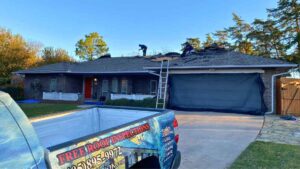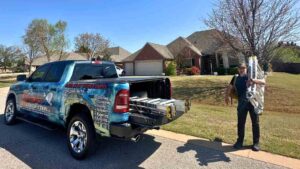In Oklahoma, severe weather isn’t just a possibility—it’s a guarantee. From damaging hail and wind to torrential rain and flash floods, storms are a fact of life during spring and summer. While many homeowners prepare by trimming trees, stocking up on batteries, or securing outdoor furniture, one critical area often gets overlooked: the roof.
When it comes to storm safety, your roof is your home’s first line of defense. If it’s compromised, everything beneath it is at risk—from structural framing and insulation to your personal belongings and indoor air quality.
At Triple Diamond Construction, we’ve helped thousands of homeowners recover after major weather events. One thing we’ve learned? The best way to avoid costly repairs is to prepare before the storm hits—and act quickly after. Here’s how to do both.
Why Roof Storm Safety Matters
Storms can damage your roof in a variety of ways—some obvious, some not. High winds may rip off shingles or flashing. Hail can bruise shingles and compromise their protective granules. Heavy rain can find even the smallest weak spot and cause water to seep into your attic or walls.
What makes storm damage especially dangerous is that it’s not always visible from the ground. Many Oklahoma homeowners don’t realize they have a problem until water stains show up on the ceiling—or a contractor spots a major issue during a future inspection.
Storm safety isn’t just about staying inside during bad weather. It starts well before the storm arrives and continues after the skies clear.
How to Prepare Your Roof Before a Storm
1. Schedule a Pre-Storm Roof Inspection
The best way to ensure your roof is storm-ready is to have it inspected by a professional. A trained eye can spot minor issues—like loose shingles, weak flashing, or failing sealant—that could turn into major problems when winds pick up. At Triple Diamond Construction, we offer free inspections that give you peace of mind before the next storm system moves in.
2. Secure or Remove Loose Items Around the Roofline
Patio furniture, hanging decorations, satellite dishes, and loose gutters can become dangerous projectiles in strong winds. Make sure anything that isn’t bolted down is either removed or secured. Trim tree branches that hang over your roof to reduce the risk of impact damage.
Need help preparing for storm season? Access our free online storm preparation guide for OKC homeowners.
3. Clean Your Gutters and Downspouts
Clogged gutters can prevent water from draining properly, leading to backups, rot, or ice dams. Make sure all drainage systems are clear before a storm to allow water to move off the roof efficiently. Get tips on how to do that with our free gutter cleaning checklist.
4. Check Attic Ventilation and Seals
Proper airflow in your attic can reduce the risk of heat and moisture buildup. At the same time, check that vents and attic windows are sealed well enough to keep driving rain out. Any area where wind-driven rain can enter is a vulnerability.
5. Document the Condition of Your Roof
Take photos of your roof and exterior before a storm—especially if you know bad weather is coming. These images can be useful later if you need to prove storm damage occurred, especially when filing an insurance claim.
What to Do After a Storm Hits
Once the storm has passed, your first step should always be to assess your property safely from the ground. Here’s what to look for:
1. Perform a Visual Check from the Ground
Walk around your home and check for:
- Missing or damaged shingles
- Debris on the roof or around the yard
- Bent or hanging gutters
- Dented vents or flashing
- Water pooling near the foundation
If you see anything out of the ordinary—or if your neighborhood experienced hail, strong wind, or heavy rain—call a roofing professional for a full inspection.
2. Check Inside Your Home and Attic
Head into your attic or upper rooms and look for:
- Damp insulation or rafters
- Water stains on the ceiling or walls
- Musty odors (a sign of early mold growth)
- Signs of light shining through roof decking
Even if your ceiling appears dry, moisture can hide behind walls and insulation, so a thorough check is always a good idea.
3. Don’t Attempt DIY Repairs
Storm damage might be more severe than it looks—and climbing on a roof after bad weather is dangerous. Leave the inspection and repairs to a licensed roofing contractor who can work safely and document the damage properly.
4. Schedule a Post-Storm Roof Inspection Immediately
If your home was in the path of the storm—even if you don’t see damage from the ground—get your roof professionally inspected. A certified roofer can identify issues you might miss and help guide you through the next steps, whether that’s a simple repair or an insurance claim.
5. Act Quickly to Prevent Further Damage
Waiting too long to address damage could result in:
- Mold and mildew growth
- Wood rot in your attic
- Voided warranties
- Denied insurance claims
Even if you’re not ready to commit to full repairs, temporary solutions like emergency tarping can protect your home from further damage while you plan next steps.
Triple Diamond Construction: Your Storm Safety Partner in Oklahoma
We understand how stressful storm season can be for Oklahoma homeowners. That’s why we offer:
- Free pre- and post-storm inspections
- Emergency tarping and fast-response repairs
- Insurance claim support
- Local crews who know what to look for after hail, wind, and flood events
Our mission is simple: help you protect what matters most, starting at the top.
Final Thoughts: Don’t Wait for the Next Storm to Take Action
Storm safety starts before the clouds roll in. By preparing your roof ahead of time and knowing what to do after a storm, you can prevent serious damage and costly repairs. And when in doubt, don’t guess—call the pros.
If your home has experienced recent severe weather or you just want to be proactive this season, call Triple Diamond Construction at 405-895-9972 or schedule a free roof inspection online using this link: https://triplediamondok.com/free-roof-inspection-okc/
We’ll be there when you need us—before, during, and after the storm.





